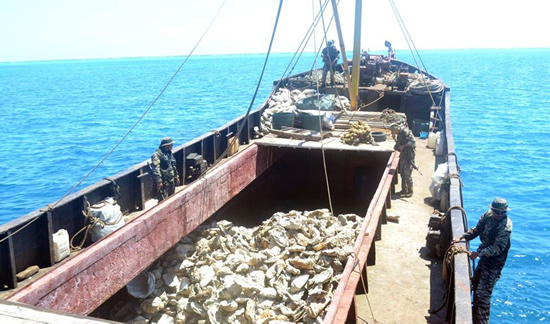
This undated handout photo taken by Philippine navy and released April 11, 2012 by the Department of Foreign Affairs shows Philippine navy troops inspecting a Chinese fishing vessel loaded giant clam shells after it was intercepted off scarborough Shoal which led to a tense standoff between Philippines' warship and Chinese maritime surveillance ships.
According to press reports this morning, the Philippine navy is currently locked in a standoff with Chinese government vessels in the South China Sea.
The Gregorio del Pilar, a refurbished former U.S. Coast Guard cutter transferred to the Philippines last year, is being blocked by two Chinese surveillance vessels in the Scarborough Shoal, which is located in an area just 137 miles off the coast of the Philippines and hundreds of miles from China.
While on routine patrol, a Philippine vessel discovered eight Chinese fishing ships illegally seizing coral and live sharks. Subsequently, two Chinese surveillance vessels positioned themselves between the Philippine ship and the Chinese fishermen, preventing any arrest or further action. Neither side seems willing to back down as they scramble to find a diplomatic solution.
The standoff comes amid persistent bellicose Chinese rhetoric over the South China Sea. Writing in China’s Global Times, the mouthpiece for semi-official belligerent statements, Chinese Major General Luo Yuan stated that the Philippines is facing its “last chance” to back away from its claims. Last year, the Global Times warned the Philippines to “mentally prepare for the sound of cannons” in the South China Sea.
And it’s not just the newspapers. Much more diplomatically, China’s Foreign Ministry routinely lays claim to areas of sea bordering on the Philippines. (The Chinese barely cracked the door to a solution a few weeks ago when they denied sovereignty over the entire South China Sea, but they have since reverted to their old talking points.)
Last week, a semi-annual Association of Southeast Asian Nations (ASEAN) summit failed to produce real progress on the South China Sea, as China-friendly Cambodia—fresh from Hu Jintao’s convenient visit on the eve of the summit—did not include the issue on the agenda until late in the summit, after Philippine insistence. Then, Philippine and Vietnamese efforts to strengthen ASEAN’s position by creating a common ASEAN Code of Conduct before involving China was met with a degree of indifference.
For the U.S., it is vital to continue supporting the Philippines, as a strong Philippine position in the South China Sea is the best way to ensure peace and prevent Chinese adventurism. After all, the cutter we provided them last year is in the thick of this standoff—without it, the Philippines would never have known of illegal Chinese fishing. Bolstering the Philippines’ flagging ability to defend its territorial sovereignty, at least to a position of self-sustainability, is essential.
In addition, if shots are fired, the U.S. is treaty-obligated to begin formal consultations with the Philippines on how best to support it. While the U.S. takes no stance on territorial claims, the 1951 Mutual Defense Treaty is explicitly clear that any attack on Philippine “armed forces, public vessels or aircraft in the Pacific” will be deemed “dangerous to [America’s] own peace and safety” and obliges the U.S. to “act to meet the common danger,” a position reaffirmed by then-Ambassador Thomas Hubbard in 1999.
But it won’t come to that so long as the U.S. continues to reinforce the Philippines’ ability to protect its own territorial integrity and remains resolute in its treaty commitments. Negotiating from a position of strength, not weakness, will allow the Philippines the best opportunity to reach an agreeable compromise with the Chinese.
Recently, the U.S. and the Philippines have discussed increasing U.S. ship visits and exercises, and the U.S. is currently transferring a second cutter to the Philippine navy. But more can be done. The Philippines should be provided the F-16s they want on a program that will best equip and train them in their usage, as well as the two additional cutters that it has requested, among other requested equipment.
Moreover, the U.S. and the Philippines are in discussions on more cooperation, from potentially operating reconnaissance flights from Philippine airfields to rotating U.S. Marines through Philippine facilities for training, like they are now doing in Australia. Finally, to maintain the credibility of its own commitments, the U.S. has to reverse course and increase its own Navy’s shipbuilding budget.
Most likely, this current Philippine–China standoff will not end in conflict. But China is becoming more aggressive with each passing day, and without agreement between ASEAN and China, these incidents will only increase in frequency and intensity. Until a diplomatic solution can be reached, it is up to the U.S. to guarantee stability in the region. And this is best done through strong support for our treaty ally the Philippines.
























